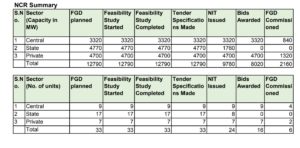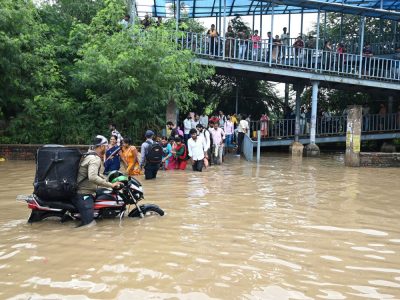Delhi’s thermal power plants are emitting sulphur dioxide at very high levels, adding to the winter-time pollutants shutting out the sun in the city’s skies
An analysis by Greenpeace India and the Centre for Research on Energy and Clean Air (CREA) recently revealed that India emitted 21% of sulphur dioxide in 2019. With this finding, India remains at the top for the fifth consecutive year.
However, in 2019 India recorded a significant decline of approximately 6% global anthropogenic (human-made) SO2 emissions after four years. The hotspots for SO2 emission are those cities where heavy coal-based thermal power plants (TPPs) or clusters of such plants are located.
Delhi is not among the largest emitting cities, presumably because there are not many heavy TTPs in the main city.
Nevertheless, the ambient air of Delhi throughout the year holds a significant amount of SO2 and sulphates. The Economic Survey of Delhi 2017-18 said that Delhi residents are breathing five times more sulphur dioxide than a decade ago. NO2, another poisonous gas, which was at 43.1 μg/m3 level in 2008, increased to 73.55 μg/m3 in 2017.
As per the April 2019 analysis by the Council on Energy, Environment and Water (CEEW), industries and power plants are the third and fourth largest source of Delhi’s pollution followed by vehicles and road dust.
SO2 and NOx can convert into PM2.5 through secondary processes and chemical reactions, increasing the risk of stroke, lung cancer, premature death and heart disease.
Avinash Chanchal, climate campaigner at Greenpeace says, “The health impacts caused by the pollutant result from both direct exposure to SO2 as well as exposure to fine particulate matter (PM2.5), which is produced when SO2 reacts with other air pollutants to form sulphate particles.Health impacts from PM2.5 air pollution make it the fifth greatest risk factor for death from any cause worldwide. It is a cocktail of all different kinds of pollution ranging from heavy metals to secondary gaseous pollutants such as sulfates.”
As per data collected by Greenpeace, 31,000 people have succumbed to air pollution in Delhi since 1 January. The PM 2.5, NO2, SO2 are the major air pollutants.
In Delhi-NCR, 11 TPPs are operational. On Tuesday, when we checked the air quality of those regions where TPPs are functioning, pollutants like SO2, NOx and PM2.5 were higher there. To take just one example, in Badarpur region, these gases were at toxic levels throughout the day.
“SO2 hotspots that use coal combustion for power generation and industry account for more than 52% of total global anthropogenic SO2 emissions. In India, coal-fired power stations are the major source of SO2 emissions and other hazardous pollutants. But unfortunately most of the power plants are not meeting the new emission standards notified by MOEFCC in 2015. It is high time to install flue-gas desulfurisation (FGD) in power plants, to remove SO2 from exhaust flue gases of fossil-fuel power plants and industries,” Chanchal advocated.
India opted for a phased approach. To limit sulphur dioxide and nitrous oxide emission from thermal plants, India directed 440 coal-fired units to limit pollution by December 2022. The deadline was extended twice by the government. Government is considering extending the deadline again as the process of FGD installation is taking time. Many private players are already demanding extension.
The Central Electricity Authority (CEA) is also proposing the extension of the deadline. As per a news report, CEA says that immediate installation of FGD is required only in the SO2 hotspots, while in other units FGD can be installed in a phased manner.
Sunil Dahiya, analyst at CREA considers the current demand by CEA irresponsible. He said, “CEA is a body that has got a mandate from the SC to make sure that the TPPs complies with emission standards but even after five year since notification was issued, it has done nothing but release periodic reports.”
In Delhi-NCR, TPPs had to retrofit FGD by 31 December 2019. Only Mahatma Gandhi Super Thermal Power (660×2 MW) plant has FGD installed and operational as per CEA report. Other plants are lagging and missing the deadline.
TPPs are still either in the bidding stage or yet to be awarded bidding. As per the September status report, out of 33 FGD planned, bids have been awarded for 16 units; for six plants FGD has been commissioned. Interestingly, no FGD had been commissioned for TPPs operated by the state government.

Experts say that the installation process takes time, considering existing power plants are not designed for FGDs; time required may be more than it is being assumed. Therefore, the Association of Power Production (APP) is demanding more time. In a letter to the government, APP’s Director General Ashok Khurana said in March that installation of FGD takes upto 27-30 months. Reuters reported that banks are reluctant to provide funds for that due to the stress level of power plants.
There is a perception that post-FGD installation, electricity would become costlier by at least Re 0.3 to 0.4 per unit. But weighing it against the cost to GDP incurred by pollution, this is not a high price to pay. From 1 January to 4 September, pollution has cost 6.6% of Delhi’s GDP.
Some experts are arguing in favour of shifting to Indian coal in thermal power plants, as it has only 0.5% sulphur content. They say it is a viable option instead of investing in FGD technologies for all the plants barring hotspots. These advocates argue that since private players are investing in coal and India is focusing on producing more coal, shifting to Indian coal is a viable option.
Dahiya denies this claim. He says these arguments are presented just to misguide people and policymakers. “Many power plants are already using Indian coal and emitting more than 1000 mg/Nm³. SO2 concentration was never the issue, SO2 is a very reactionary gas and within a few hours, it converts to sulfates, then it becomes very poisonous.” he said, “this is the reason why the Government had to bring emission standard notification”.
Air pollution is the biggest issue for Delhi. As winter approaches, the ambient air of Delhi brought the issue of pollution again in focus. How long will the government ignore the elephant in the room: TPPs. They are flaunting SC guidelines and still operating.





